Sandra Byrd's Blog, page 22
December 18, 2011
A Tudor Christmas: Part Three
by Wendy Pyatt
Tudor Christmas Gifts
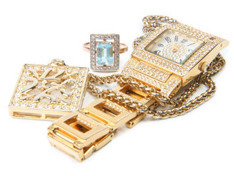 The Tudors gave gifts at the New Year. Every important person was expected to give the monarch a New Year's gift and then receive one in return. This was considered so important that a list, called the Gift Roll, of all gifts was kept. Acceptance or rejection of a gift was vital as this quite often had a hidden meaning! For example, in 1532 Henry VIII accepted Anne Boleyn's gift but rejected Katherine of Aragon's; Anne and Henry were married the following year. The women of Henry's court are listed as giving him embroidered shirts, and other craftsmen would show off their skills, too. For example, the Hans Holbein painting of Edward was given as a Christmas gift.
The Tudors gave gifts at the New Year. Every important person was expected to give the monarch a New Year's gift and then receive one in return. This was considered so important that a list, called the Gift Roll, of all gifts was kept. Acceptance or rejection of a gift was vital as this quite often had a hidden meaning! For example, in 1532 Henry VIII accepted Anne Boleyn's gift but rejected Katherine of Aragon's; Anne and Henry were married the following year. The women of Henry's court are listed as giving him embroidered shirts, and other craftsmen would show off their skills, too. For example, the Hans Holbein painting of Edward was given as a Christmas gift.
Another example of the meaning behind Tudor gift-giving occured when Sir Philip Sidney enraged Elizabeth I by suggesting she should not marry; for the New Year he gave her a jeweled whip to show subjection to her will. In 1568 Elizabeth I was given a pair of cambric sleeves by Mr. Adams, schoolmaster of Queen's pages.
Robert Dudley, Earl of Leicester, was a very successful gift giver; he gave silk stockings in the 1st year of Elizabeth's reign and also possibly the world's first wrist watch. Epigrams were often sent as New Year's gifts and contained one or two verses, like a short poem, usually with a sarcastic or satirical thought. From 1582 Elizabeth began to receive New Year gifts of gold, silver and rock crystal handled forks – forks were new to the country, and therefore, to court!

December 10, 2011
A Tudor Christmas: Part Two
by Wendy Pyatt
Tudor Christmas Traditions
 Christmas and New Years was the greatest festival celebrated by the Tudors. Advent was a time of fasting; Christmas Eve was particularly strictly kept with no meat, cheese or eggs. Celebrations began on Christmas Day when the genealogy of Christ was sung while everyone held lighted tapers. The Monarch was required to attend mass and would be expected to wear new clothes. He would progress from the Privy Chamber to the Chapel Royal dressed in coronation robes of purple and/or scarlet complete with crown.
Christmas and New Years was the greatest festival celebrated by the Tudors. Advent was a time of fasting; Christmas Eve was particularly strictly kept with no meat, cheese or eggs. Celebrations began on Christmas Day when the genealogy of Christ was sung while everyone held lighted tapers. The Monarch was required to attend mass and would be expected to wear new clothes. He would progress from the Privy Chamber to the Chapel Royal dressed in coronation robes of purple and/or scarlet complete with crown.
The whole 12 days of Christmas was celebrated (25th December – 6th January), but not every day was celebrated equally. All work stopped except looking after animals; spinning was even banned as this was the most common occupation, for women and flowers were placed around the spinning wheels. People would visit friends and it was seen as very much a community celebration. Work re-started on Plough Monday, the first Monday after 12th night.
In Tudor Times the most sumptuous feast were held on 25th Dec, 1st Jan and 6th Jan. In 1532/33, the preparation for the 12th night feast at Greenwich palace required the building of a temporary boiling and working house. Up to 24 courses would be served, much more than was needed for the guests but it was a status symbol. Left over food was always used to feed the poor.
Tudor Christmas had a definite purpose. Because society was very strictly organised, these celebrations acted as a pressure release, a time when everything was turned on its head, the world turned inside out and upside down. Certain sections of society were even allowed an unusual degree of freedom. For example, in ecclesiastical communities, the tradition of the boy bishop was practised. A choir or alter boy would be elected for a short period either on 6th December (St Nicholas Day) or 28th December (Holy Innocents Day) with the idea being that it showed the boys the honour and dignity of holy orders. This was banned in 1541 because it was seen as mocking the church authorities and by implication the head of the church, who of course was Henry VIII. However, the practice possibly dates back to the 10th century and never completely died out. The tradition is still continued at Hereford, Gloucester, Westminster (RC) and Salisbury cathedrals to this day.
There was a similar tradition in secular circles. They had the Lord of Misrule. He was like a mock king and supervised entertainments or rather unruly events involving drinking, revelry, role reversal and general chaos. One of the games the Tudors would have been familiar with was Blind Mans Bluff! The inspiration for this Lord of Misrule was the earlier 11th century tradition of The Feast of Fools.
Another example of role reversal which started in the Tudor period is that of Barring Out, where pupils would take possession of the school by locking the staff out until certain demands regarding playtimes and homework were met. It was particularly common in Northern counties and was usually around the 6th December which is St Nicholas Day (the patron saint of children).
A favorite Tudor Christmas tradition was the performing of plays. There are records from the early 16th century that both Oxford and Cambridge colleges employed travelling players in their Christmas entertainments. There are also records of a play being performed for Cardinal Wolsey at Grays Inn during Christmas 1526. Coventry mystery plays which the Coventry carol was written for, tell the story of Herod's murder of the innocents. Mystery plays are still performed in Coventry even today.
The Tudors also possibly practiced the Viking custom of burning a Yule Log. The Log would be decorated on Christmas Eve for the 12 days of Christmas and then burned. It was considered lucky to keep some remains to help light the following years log.
All sports on Christmas day were banned by Henry VIII in 1541 (except archery of course). In theory gambling, tennis, bowls and other games were forbidden to all but the very wealthy except at Christmas! Jousting was also a popular sport during the Christmas period. In 1551, Edward VI passed a law that everyone had to walk to church on Christmas day; it's still on the books today. A Tudor Christmas was always a 2 week period of concerted power, politics, and networking as the monarch would be surrounded by courtiers, nobility and other important people.
Originally published at www.localhistories.org

December 6, 2011
A Tudor Christmas: Part One
by Wendy Pyatt
Tudor Christmas Decorations
 The Tudors did not have Christmas trees, although they were around in 16th century. It is a Baltic/northern German tradition and even then it is not recorded until 1520. The first known record of a Christmas Tree was in Riga, Latvia in 1510.
The Tudors did not have Christmas trees, although they were around in 16th century. It is a Baltic/northern German tradition and even then it is not recorded until 1520. The first known record of a Christmas Tree was in Riga, Latvia in 1510.
The decorations they would have used would have been natural ever greens like holly, ivy, yew, mistletoe, box and laurel. They would not have decorated their houses until Christmas eve as it was thought to be unlucky to do it before. The more modern tradition of fairy lights is said to originate from the 16th century Legend of Martin Luther. He was walking in the snow covered woods and seeing stars through the trees was struck by the beauty, he took a tree home and put candles on it, that's why we have fairy lights!
Tudor Christmas Carols
The earliest recorded collection of Christmas carols dates from 1521 published by Wynken de Worde and includes The Boars Head Carol. Carol means a dance with a song and carols flourished throughout Tudor times as a way to celebrate and to spread the message of the nativity. Other Christmas carols the Tudors would have been familiar with include The Coventry Carol, While Shepherds Watched, The First Nowell, Angels from the Realms of Glory, Ding Dong Merrily on High ( French in origin), In Dulci Jubilo, and We Wish You a Merry Christmas. Wassail carols, of which there are many, were also popular and most areas of the country have their own version.
Originally published at www.localhistories.org

November 21, 2011
The Art of Courtly Love
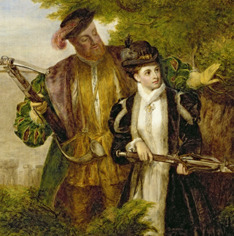 The art of courtly love and chivalric romance so popular during the early medieval period saw a revival during the Tudor era. Because the majority of noble marriages were arranged, with the focus being on financial or political gain, courtly love was a gentle, parrying game of flirtation wherein people might express true, heart-felt affections.
The art of courtly love and chivalric romance so popular during the early medieval period saw a revival during the Tudor era. Because the majority of noble marriages were arranged, with the focus being on financial or political gain, courtly love was a gentle, parrying game of flirtation wherein people might express true, heart-felt affections.
According to historian Eric Ives, "The courtier, the 'perfect knight', was supposed to sublimate his relations with the ladies of the court by choosing a 'mistress' and serving her faithfully and exclusively. He formed part of her circle, wooed her with poems, songs and gifts, and he might wear her favor and joust in her honor … in return, the suitor must look for one thing only, 'kindness' – understanding and platonic friendship." Many of the plays and entertainments in Henry the Eighth's court reflected these values and Henry himself, early in his reign, was very chivalrous and courtly indeed.
Andreas Capellanus, in his definitive twelfth century book, The Art of Courtly Love, set out to inform "lovers" which gifts could be offered, (among them a girdle, a purse, a ring, or gloves) and to clarify the signs and signals that indicated such a love game was underway – or on the wane. This way the participants, and those around them at court, would know that the game was afoot. Physical attraction was one of many factors in courtly love, but sexual expression was not necessarily an element of the relationship. Cappellanus further posits that a beautiful figure, excellence of character, and extreme readiness of speech are required for a man or woman to fall in love, with character being the most noble element
of all.
The longest game of courtly love, played out before all of Europe, was undoubtedly between Anne Boleyn and Henry VIII. The relationship started out as courtly flirtation but as sometimes happened, it then progressed to a more serious, deeper connection with a significant goal in outcome and purpose. Although their courtly relationship did not follow each of the thirty-one rules Capellanus lists from the "King of Love," it did dovetail with some of them – a few of which have been examined below.
Rule II. He who is not jealous cannot love. This rule immediately brings to mind the incident between Henry and Thomas Wyatt during a game of bowls. Thomas Wyatt used one of Anne's ribbons and bauble to mark distance, and he meant to use it to provoke or test Henry's jealousy. Henry, predictably, flew into a possessive bluster. Anne recovered nicely from Wyatt's foolishness, but there was no further doubting that she was Caesar's and not to be touched.
Rule IV. It is well known that love is always increasing or decreasing. One of the most extraordinary things about Henry's affection for Anne is that she was able to not only capture it but build upon it over a remarkable period of time – seven years from 1525 when it was clear he had fallen for her, to 1533 when their public marriage took place – allegedly, without physical consummation. He did not become bored or disinterested in her companionship. This was no mean feat when one considers Henry's short attention span. He wrote tender love letters to Anne, some of which still exist, a powerful demonstration of his growing love as Henry loathed writing.
Rule XI. It is not proper to love any woman whom one would be ashamed to seek to marry. Much has been made of the fact that Anne "held out" sexually from Henry for personal reasons, and that Henry wanted his heirs by her to be legitimate, two among other valid reasons why they did not simply have an affair. But there is strong evidence to suggest that Henry found Anne worthy of marriage – he crowned her –and took great pride in displaying her before all the court. In Anne it is clear that for some time Henry believed he'd found a spirited soul mate who was as vibrant as he was and he desired for her to be his wife.
Rule XIV. The easy attainment of love makes it of little value; difficulty of attainment makes it prized. We're often reminded that Henry left his wife and broke away from the Roman Catholic Church during his pursuit to marry Anne, courting war and ill will in the process. But Anne, too, made sacrifices. Her child-bearing years were quickly slipping by; there was a rush to judgment as she was reviled by much of the populace as a usurper; she had no official role nor position; and, finally, there was no guarantee that she would even have her marriage. Both of them risked much. Only one of them, in the end, lost everything.
Rule XXVIII. A slight presumption causes a lover to suspect his beloved. In the end, it took very little to convince Henry that Anne had betrayed him, a ridiculous acceptance of circumstances that demanded Anne be in places she clearly was not and act in ways that would never have gone unnoticed and that were in stark contrast to her character. One must ask, why? Cappellanus answers that question for us, too. "…when love has definitely begun to decline, it quickly comes to an end unless something comes to save it."
At the point when the King's affections began their precipitous drop, long after their game of courtly love was over and well into their marriage, the only thing that could have saved Anne was the son she miscarried. Chivalric values included integrity, protecting the vulnerable, and acting with self-sacrificing honor. Sadly, Henry did not turn out to be the "perfect knight" Ives speaks of. In Capellanus's concluding section, The Rejection of Love, he references, "…lovers who have been driven by love to think of killing their wives and they have even put them to a very cruel death – a thing which all will agree is an infamous crime."
Unfortunately, this evil came to pass. In Anne's final months, Henry was likely not driven to this crime by love of another woman, although he clearly had one in mind, but perhaps primarily out of love for himself, a nonvalorous motivation indeed.
Written by Sandra Byrd, this article first appeared at the website On The Tudor Trail. Please visit that site for a treasure of riches about Anne Boleyn.

November 5, 2011
Building the Bridge
Every creator painfully experiences the chasm between his inner vision and its ultimate expression. The chasm is never completely bridged. We all have the conviction, perhaps illusory, that we have much more to say than appears on the paper. ~ Isaac Bashevis Singer
As a writer, I can definitely vouch for the second part of this quote. I do have a lot to say, and not all of it makes it to the page. In many ways, this is a blessing. The Delete Key and the waste basket are two of a writer's best friends. Though a first draft requires that I turn my inner editor off, the second, third and fourth drafts live for and with that inner editor, making the book better, honing the novel along with my craft.
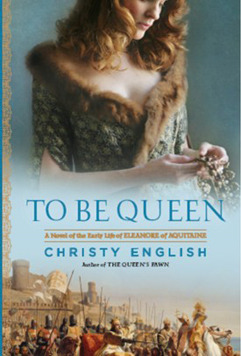 The first part of this quote is also true. We all cringe at the distance between what we mean to say, and what comes onto the page. There is always more beauty in us than we can express, depths that we can not always reach. But we sit down at the computer anyway, and reach for the best within us. The chasm as Mr. Singer says may never be completely bridged. But that chasm is where the good stuff is. The effort to reach across it, to make my work better than it was yesterday, is part of the reason I stay in the chair. I hope by the end of my life to have built a better bridge between the beauty of a project as I see it in my mind, and the beauty that makes it onto the page. It is a bridge worth building, even if it is never finished.
The first part of this quote is also true. We all cringe at the distance between what we mean to say, and what comes onto the page. There is always more beauty in us than we can express, depths that we can not always reach. But we sit down at the computer anyway, and reach for the best within us. The chasm as Mr. Singer says may never be completely bridged. But that chasm is where the good stuff is. The effort to reach across it, to make my work better than it was yesterday, is part of the reason I stay in the chair. I hope by the end of my life to have built a better bridge between the beauty of a project as I see it in my mind, and the beauty that makes it onto the page. It is a bridge worth building, even if it is never finished.
Find out more about author Christy English at her website: http://www.christyenglish.com/

October 7, 2011
Seeking to be a One Term Writer
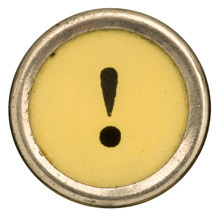 No matter what their political affiliation or lack thereof, most people are irritated by the fact that our elected officials seem to spend more time, creative energy, and enthusiasm campaigning for the next term rather than delivering what was promised for the current term. When I watch them on TV I want to shout, "Just get to work!"
No matter what their political affiliation or lack thereof, most people are irritated by the fact that our elected officials seem to spend more time, creative energy, and enthusiasm campaigning for the next term rather than delivering what was promised for the current term. When I watch them on TV I want to shout, "Just get to work!"
Why would we re-elect anyone to do a job they aren't faithfully doing right now? Businessman Bob Johnson, in an interview with CBS news, urged today's politicians to, "simply sacrifice your political job for the job that American people want you to do. That's as simple as that. Be willing to be a one-term congressperson. Be willing to be a one-term president, be willing to be a one-term senator. Take that position. That the issues before the country are far greater than me returning to Washington and starting the same old treadmill over again."
It struck me, then, that is often how we writers work. We, too, have "terms." Most of us write from contract to contract, with no promise that there will be a job after we type "The End" at the conclusion of a manuscript, or at the submission of a short story, blog, or article. This can lead to worry, over-thinking and planning the next move, strategizing to save or build a career. We can compulsively check our amazon rankings, our goodreads reviews (or other authors'), or have too much concern about if everything we're doing right now is good enough to lead to another job next term. Worst of all, it steals our joy and drains current creative energy that we could be pouring into the project right in front of us, you know, the one with the ticking clock/deadline. The one we were so eager to write when we proposed it!
I can't remember who offered this writing insight, but it's brilliant: When you begin to hoard your best ideas, phrases, time, and excitement for the next work, you're in trouble. They need to go into THIS book, this proposal, this idea, this article, this paragraph, everything that's on my screen (or should be!) today. When I'm worrying about my career, my mind is not free to explore the story I'm telling right now, which leeches it of its life. This nudges writers toward self-fulfilling the doom prophecy we're concerned about in the first place. Instead, I must press on and trust that the manna will fall tomorrow, too.
I want to tell politicians: Do the job you've already said you were going to do. Follow through and meet the promises that you've already made; I believed in you when you spoke them, I caught your vision. I know you have the right stuff. If you deliver on that promise, I'll be eager to elect you for the next term, even if you're not perfect. If not, I'll have to move on.
I suspect my readers might be thinking the very same thing.

September 19, 2011
Rice Balls
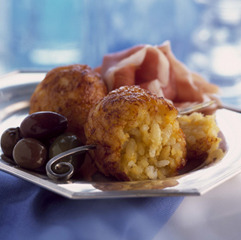 Rice Balls
Rice Balls
Serves 10 (approximately 36 rice balls)
Rice balls like these, today known as "arancine" or little oranges, are still made in many parts of Italy. During the Renaissance and Elizabethan eras these savory balls would have been colored purple or yellow with dried edible flower petals or saffron. This dish can be easily recreated using food coloring to produce the different colored balls. Of course, they are delicious without the coloring!
1 pound Italian rice (such as vialone or origianario rice)
1/3 cup cream
1 large egg, beaten
1 cup grated caciocavallo cheese
2 tablespoons sugar
Yellow food coloring (optional)
Purple food coloring (optional)
3/4 cup vegetable oil
1/2 cup flour or dried bread crumbs
Cook the rice according to the package directions. Combine the cooked rice, cream, egg, cheese, and sugar in a large bowl. Cover and refrigerate until thoroughly chilled, or up to 2 days.
If desired, divide the rice into 3 equal portions. Using the food coloring, color 1 portion bright yellow, 1 portion purple, and leave the remaining portion white.
Form each of the portions of rice into 1 inch diameter balls.
Place the flour or bread crumbs on a flat plate. Heat 3 to 4 tablespoons of oil in a skillet over medium-high heat. Lightly roll 1 color of the rice balls in the flour or bread crumbs. Cook, turning occasionally, until completely browned on all sides. Remove the rice balls from the pan and drain on paper towels. Discard the oil in the pan, wipe it clean, and repeat the process with the remaining rice balls.
© Shakespeare's Kitchen: Renaissance Recipes for the Contemporary Cook by Francine Segan.

September 5, 2011
Life of Tudor Women, Part Two
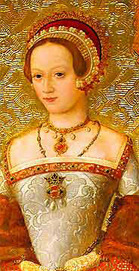 Tudor Women and Fashion Rules It's hard to imagine being told what fabrics and colors you could wear, isn't it? Sumptuary Laws in place during Tudor times regulated the wearing of rich fabrics to the upper classes, the number of meal courses to be served for specific guests, and the purchases of luxuries allowed for each social class. Henry VIII, in particular, was concerned about the rise of the wealthy merchant class with no connection to nobility, and so he revived and expanded the restrictions on clothing and other expenditures. For example, only members of the royalty were allowed to wear ermine, and only the nobility were allowed to wear clothing trimmed in fox or otter. Anne Boleyn was known for her stylish attire, she had it early and further developed it while in France. She brought French sophistication back to the English court and was known especially for her French hoods, and for adding each day a small, but different accessory to her wardrobe which was always fresh.
Tudor Women and Fashion Rules It's hard to imagine being told what fabrics and colors you could wear, isn't it? Sumptuary Laws in place during Tudor times regulated the wearing of rich fabrics to the upper classes, the number of meal courses to be served for specific guests, and the purchases of luxuries allowed for each social class. Henry VIII, in particular, was concerned about the rise of the wealthy merchant class with no connection to nobility, and so he revived and expanded the restrictions on clothing and other expenditures. For example, only members of the royalty were allowed to wear ermine, and only the nobility were allowed to wear clothing trimmed in fox or otter. Anne Boleyn was known for her stylish attire, she had it early and further developed it while in France. She brought French sophistication back to the English court and was known especially for her French hoods, and for adding each day a small, but different accessory to her wardrobe which was always fresh.
Tudor Women as Mothers Children were treasured in Tudor times as they are today. A woman would probably have had a child every one to two years. Many women died in childbirth due to poor medical hygiene, and the chance at least one of their children would die was significant. Consider that Catherine of Aragon is reported to have been pregnant at least six times, but had only one son who lived just a few days and one surviving daughter, Mary. Anne Boleyn was pregnant at least three times, perhaps four, but only Elizabeth survived. Kateryn Parr and Jane Seymour each bore one child and both women died of childbed fever. Even the most noble of women were not spared the grief of frequent miscarriages or stillborn children.
Giving birth for women of the noble class would have been a social event attended by the mother's closest friends and a midwife arranged ahead of time. Doctors almost never attended births. Puerperal sepsis, or 'childbed fever', was common as handwashing was rarely practiced (by midwives or doctors.) A contemporary study for the UK's National Institute for Health estimates the maternal death rate in the 16th century as 26 women per every 1,000 births. Compared to today's figure in the UK of .11 per 1,000 women dying as a result of childbirth, you can see that childbirth was definitely a hazardous undertaking in Tudor times!
Tudor Women and Social Relationships Within the social structure of Tudor times, loyalty to family, especially family of origin, took precedence. For women of noble birth, that meant that advancing the social position of their families was their primary function. Oftentimes Anne Boleyn is seen as having been "pushed" toward marriage to Henry by a socially climbing family. The truth is, all families were social climbers and Thomas Boleyn was no different than other good men before and after in seeking to advance his house, often to disasterous consequence, but sometimes, to love. Betrothals and marriages, the ability to produce an heir and their connections as ladies-in-waiting to more highly-ranked nobles would have motivated the decisions made by and for noble women of this era.
The relationships they formed within noble circles would not only have been based upon similar personalities and interests, but also the other person's ability to help them advance their family's interests. It was common for young women in noble families to leave their families for extended periods to serve at court. One type of close relationship that was familiar to women of noble households was with long-time servants who served not only as employees but also as confidantes and go-betweens with others in the household. This is clearly seen in Meg Wyatt's friendship with her longtime lady's maid, Edithe.
Glad we get to choose our men, for the most part, today!
Research Sources: Coventry.ac.uk; Elizabethan-era.org.uk; elizabethi.org; TudorsWiki; LocalHistories.org; NIH.gov

August 22, 2011
Life of Tudor Women, Part One
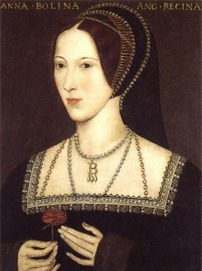 Sandra Byrd
Sandra Byrd
with Kate Eaton
Have you ever wondered what it would be like to be a woman duing the Tudor era, which is when all three Ladies in Waiting books are set? Here are some interesting tidbits about the ways a woman's life was both different and very much the same in the days of Henry VIII and his daughter, Elizabeth.
Tudor Women Had Careers Like many of us today, some women during Tudor times worked outside the home as well as raising a family. Career choices for lower class working women in 1500s England included street vendor, baker, milliner, tailor, brewery worker, textile worker, household servant or seamstress. They were not allowed to act on the stage or work as doctors, lawyers or politicians. Noble women and members of the gentry had more genteel choices, but those still required hard work! Many were tapped to serve as ladies-in-waiting (much like a personal assistant) for a woman of higher rank. More senior ladies-in-waiting might also serve in positions such as Mistress of the Wardrobe. Imagine keeping up with Anne Boleyn's wardrobe needs, which is what Meg Wyatt, as her Mistress of the Robes, did! Within noble households, you would also also find women working as governesses.
Tudor Women Trained to Run Households Even though many of us have careers, the responsibility today for raising families and running households still falls mainly on women. It was the same during Tudor times, with young girls of all social classes being taught how to keep household accounts, manage or perform daily household tasks, grow and use medicinal plants, and represent their husbands well. Queens sometimes stepped in to rule while the king was away at war, which is what Katherine of Aragon and Kateryn Parr did while each was married to Henry VIII. Upper class women supervising large houses were expected to know the requirements of meal preparation, food storage, spinning of yarn and weaving, brewing of ale, and making necessities such as candles and soap. They would have been expected to keep their husband's estates running smoothly in his absence. In the merchant class, men often employed their wives and daughters, who ran the business when necessary.
Tudor Women Were Obedient In most cases the young woman in the time of Henry VIII was raised to obey her parents, her Church and her husband. In the upper social strata, young women were married to whomever would most benefit her family or monarch. Some noble women during this time, however, were educated and wielded power by advising their husbands and forming favorable alliances. During Tudor Times, women promised to obey their husbands at marriage, but Kate Middleton, The Duchess of Cambridge, did not when she recently married Prince William!
Tudor Women and Marriage Women were expected to marry and have children, no matter what social class, during the days of Henry VIII and Anne Boleyn. Marriages were usually arranged for adolescent girls in the noble class, but most lower class women married in their teens and twenties. Sometimes early marriages were consummated years after the marriage if the girl was deemed too young, or sometimes, such as in the case of Margaret Beaufort, mother of Henry VII, who was married for the second time by age 12 and became mother to Henry at age 13, young girls were not so fortunate. Divorce was rarely possible. When the end of a marriage was desired, the common option was for the woman to enter a nunnery, at which time her marriage would be annulled. This was the option Henry VIII presented to Katherine of Aragon when it became clear that he would not get a male heir from her.
More to come in Part Two …

August 13, 2011
See No Evil, Hear No Evil, Speak No Evil
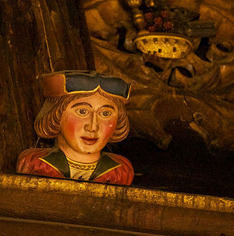 Eavesdroppers at Hampton Court Palace
Eavesdroppers at Hampton Court Palace
Henry VIII had a famously acquisitive nature – and it wasn't limited to women. The man also had a passion for real estate. As king, he inherited many castles and palaces owned by the crown, but throughout his reign he added others by purchase, trade or payment of debt; through reclamation to the crown due to attainder; "recovering" property through the dissolution of assets formerly owned by the Roman Catholic church; and by "gift." A primary advisor in the early years of Henry's sovereignty was Cardinal Thomas Wolsey, a man with tastes as extravagant as the King's and who also had the means to indulge them. When the King saw Hampton Court Palace, Cardinal Wolsey's sumptuous, Thames-side property, he envied him of it. Knowing that he was on uncertain terms with the king, Wolsey offered Hampton Court Palace to him. Henry accepted the generous gift but did not reinstate Wolsey in his favor.
Once he owned the palace, Henry set about remodeling. One of the most beautiful reconstructions was to the Great Hall. The Great Hall was a large chamber where the king dined in public and where entertainments were often held. The hall, like everything else in Henry's court, was to be well-appointed to represent his power and glory. Historian Neville Williams claimed that masons worked round the clock for five years to complete the rebuilding of the hall to Henry's showy satisfaction. The room would have been overpowering to the senses, the tastes and smells of rich foods and spices, the feel of lush wood paneling and tightly woven tapestries, the music of players, the courtly flirtations. But high above the heads of the guests, tucked into the dark corners of the roof beams, lurked one of the Great Hall's most interesting features of all.
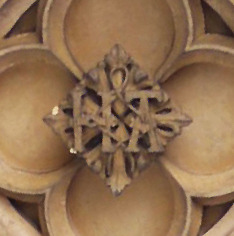 Fine embellishments had been carved into the ceiling beams, among them an HA crest for Henry and Anne Boleyn which remains to this day, but especially intriguing are the Eavesdroppers. The word eavesdropper has been in circulation since at least the 900s, coming from the old English, yfesdrype. It meant then just what it means now – someone listening to conversations in secret, watching and hearing without the permission or knowledge of the speakers. The cherubic, courtier faces would have smiled down upon guests, reminding all that Henry was aware of everything at his court through courtiers and servants. Even while at play there was never a time for loose tongues among long ears, as those who spoke freely often did to perilous consequence. At the Tudor Court, it was better to see nothing, hear nothing, and say nothing till you were in private chambers where eavesdroppers, one hoped, did not lurk.
Fine embellishments had been carved into the ceiling beams, among them an HA crest for Henry and Anne Boleyn which remains to this day, but especially intriguing are the Eavesdroppers. The word eavesdropper has been in circulation since at least the 900s, coming from the old English, yfesdrype. It meant then just what it means now – someone listening to conversations in secret, watching and hearing without the permission or knowledge of the speakers. The cherubic, courtier faces would have smiled down upon guests, reminding all that Henry was aware of everything at his court through courtiers and servants. Even while at play there was never a time for loose tongues among long ears, as those who spoke freely often did to perilous consequence. At the Tudor Court, it was better to see nothing, hear nothing, and say nothing till you were in private chambers where eavesdroppers, one hoped, did not lurk.
Eavesdropper photo copyright Helen Newall, http://tinyurl.com/hcpeavesdroppers
Entwined HA on HCP ceiling photo copyright Felicity Boardman




